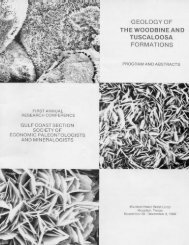Petroleum Systems of Deep-Water Basins - Gulf Coast Section SEPM
Petroleum Systems of Deep-Water Basins - Gulf Coast Section SEPM
Petroleum Systems of Deep-Water Basins - Gulf Coast Section SEPM
You also want an ePaper? Increase the reach of your titles
YUMPU automatically turns print PDFs into web optimized ePapers that Google loves.
Sea Floor Vents, Seeps, and Gas Hydrate:<br />
Relation to Flux Rate from the<br />
<strong>Deep</strong> <strong>Gulf</strong> <strong>of</strong> Mexico <strong>Petroleum</strong> System<br />
Roger Sassen<br />
Geochemical and Environmental Research Group<br />
Texas A&M University<br />
College Station, Texas 77845<br />
Harry H. Roberts<br />
Department <strong>of</strong> Oceanography and <strong>Coast</strong>al Sciences<br />
Louisiana State University<br />
Baton Rouge, Louisiana 70803<br />
Alexei V. Milkov<br />
Debra A. DeFreitas<br />
Geochemical and Environmental Research Group<br />
Texas A&M University<br />
College Station, Texas 77845<br />
Abstract<br />
A deep, hot subsurface petroleum system in the Green Canyon area <strong>of</strong> the <strong>Gulf</strong> slope has generated oil and gas<br />
synchronously with salt deformation and fault activation, producing vertical migration conduits that charge traps in<br />
the subsurface. Trapping efficiency is poor. Much oil and gas is lost to venting and seepage at the sea floor. Sea floor<br />
vent and seep environments show hydrocarbon flux that ranges from rapid venting to slow seepage, affecting hydrocarbon<br />
geochemistry and gas hydrate abundance. Active mud volcanoes that vent oil and gas are the high flux endmember.<br />
Oil and gas rapidly bypass the sediment and enter the water column. The oil from the active vent sites shows<br />
only limited bacterial oxidation. Venting is episodic and may cease altogether, and warm brines may be present,<br />
potentially destabilizing gas hydrate. It appears that gas hydrate is only indirectly associated with high flux mud volcanoes.<br />
Massive gas hydrate is most <strong>of</strong>ten found at sites <strong>of</strong> moderate flux. Gas hydrate is associated with smaller but<br />
steady vents <strong>of</strong> relatively unaltered thermogenic gas, chemosynthetic communities, and authigenic carbonate rock.<br />
Oil-related structure II gas hydrate is most abundant. Oil and free gas in sediment are bacterially oxidized in moderate<br />
flux environments, leading to accumulation <strong>of</strong> abundant authigenic carbonate rock and to H 2 S, favoring complex<br />
chemosynthetic communities. Exposed gas hydrate is transiently unstable because <strong>of</strong> changes in seawater temperature,<br />
but this is a thin-skin process and more deeply buried gas hydrate appears to be stable and accumulating.<br />
Mineralized seep sites with low hydrocarbon flux do not appear to be important with respect to gas hydrate<br />
accumulation.<br />
32

















